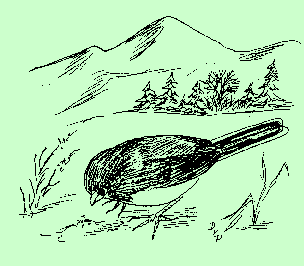|







|
. |
Gray-Headed Junco


 The genus name Junco is derived from the Latin "juncus", meaning
seed. It refers to a group of birds commonly known as "Snowbirds" because
they do not seem to mind the snow, often remaining at their breeding
grounds until snow covers the ground before descending to lower elevations.
The genus name Junco is derived from the Latin "juncus", meaning
seed. It refers to a group of birds commonly known as "Snowbirds" because
they do not seem to mind the snow, often remaining at their breeding
grounds until snow covers the ground before descending to lower elevations.

 The gray-headed junco, Junco canicens, is a little bird (5 1/2 to 6
inches in length) with ash-gray head, sides, and wings, and with a bright
rufous back as a distinguishing feature. When seen in shade they have a
bluish appearance.
The gray-headed junco, Junco canicens, is a little bird (5 1/2 to 6
inches in length) with ash-gray head, sides, and wings, and with a bright
rufous back as a distinguishing feature. When seen in shade they have a
bluish appearance.

 The song of this bird is a cheerful little sound -- "a loose, light trill
all on one pitch", as Peterson describes it.
The song of this bird is a cheerful little sound -- "a loose, light trill
all on one pitch", as Peterson describes it.

 The Gray-Headed Junco is often seen in company with other juncos, especially
the Oregon Junco (J. oreganus). The latter have black heads and
pinkish buff sides. In all juncos, the outer tail feathers are white, which
are exposed in flight. While feeding, this junco gives a characteristic
little "tsip", and at the same time a flick of its tail. Both species are
found in mountainous regions east of the Sierras, and winter at lower
elevations and as far south as Mexico. For the breeding season, the juncos
return to higher altitudes. The nest is a grassy cup placed on the ground
in or near a fallen tree or log. Four to five speckled eggs are laid.
The Gray-Headed Junco is often seen in company with other juncos, especially
the Oregon Junco (J. oreganus). The latter have black heads and
pinkish buff sides. In all juncos, the outer tail feathers are white, which
are exposed in flight. While feeding, this junco gives a characteristic
little "tsip", and at the same time a flick of its tail. Both species are
found in mountainous regions east of the Sierras, and winter at lower
elevations and as far south as Mexico. For the breeding season, the juncos
return to higher altitudes. The nest is a grassy cup placed on the ground
in or near a fallen tree or log. Four to five speckled eggs are laid.

 Numerous harmful insects, especially caterpillars, and millions of harmful
weed seeds are eaten. As a friend to agriculture, this beneficial bird
should be rigidly protected.
Numerous harmful insects, especially caterpillars, and millions of harmful
weed seeds are eaten. As a friend to agriculture, this beneficial bird
should be rigidly protected.
-- by Jennie Reynolds
|
|

